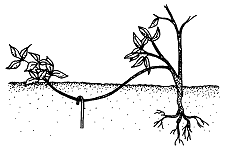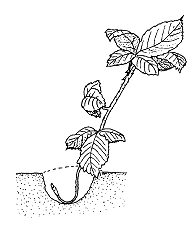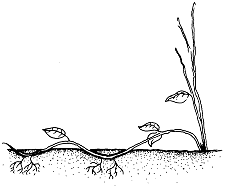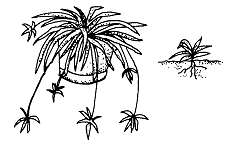Introduction
Stems that are still attached to their parent plant may form roots where they come in contact with a rooting medium. This method of vegetative propagation is generally successful, because water stress is minimized and carbohydrate and mineral nutrient levels are high. The development of roots on a stem while the stem is still attached to the parent plant is called layering. A layer is the rooted stem following detachment (removal) from the parent plant.
Some plants propagate naturally by layering, but sometimes plant propagators assist the process. Layering is enhanced by wounding the stem where the roots are to form. The rooting medium should always provide aeration and a constant supply of moisture.
Simple Layering
Simple layering can be accomplished by bending a low growing, flexible stem to the ground. Cover part of it with soil, leaving the remaining 6 to 12 inches above the soil. Bend the tip into a vertical position and stake in place (Figure 1). The sharp bend will often induce rooting, but wounding the lower side of the bent branch may help also. Simple layering can be done on most plants with low-growing branches. Examples of plants propagated by simple layering include climbing roses, forsythia, rhododendron, honeysuckle, boxwood, azalea, and wax myrtle.
Simple layering can be done in early spring using a dormant branch, or in late summer using a mature branch. Periodically check for adequate moisture and for the formation of roots. It may take one or more seasons before the layer is ready to be removed for transplanting.
Tip Layering
Tip layering is quite similar to simple layering. Dig a hole 3 to 4 inches deep. Insert the tip of a current season’s shoot and cover it with soil. The tip grows downward first, then bends sharply and grows upward. Roots form at the bend. The re-curved tip becomes a new plant (Figure 2). Remove the tip layer and plant it in late fall or early spring. Examples of plants propagated by tip layering include purple and black raspberries, and trailing blackberries.
Compound (serpentine) Layering
Compound (serpentine) layering is similar to simple layering, but several layers can result from a single stem. Bend the stem to the rooting medium as for simple layering, but alternately cover and expose sections of the stem. Each section should have at least one bud exposed and one bud covered with soil. Wound the lower side of each stem section to be covered (Figure 3). This method works well for plants producing vine-like growth such as heart-leaf philodendron, pothos, wisteria, clematis, and grapes.
Mound (stool) Layering
Mound (stool) layering is useful with heavy-stemmed, closely branched shrubs and rootstocks of tree fruits. Cut the plant back to 1 inch above the soil surface in the dormant season. Dormant buds will produce new shoots in the spring. Mound soil over the new shoots as they grow (Figure 4). Roots will develop at the bases of the young shoots. Remove the layers in the dormant season. Mound layering works well on apple rootstocks, spirea, quince, daphne, magnolia, and cotoneaster.
Air Layering
Air layering can be used to propagate large, overgrown house plants such as rubber plant, croton, or dieffenbachia that have lost most of their lower leaves. Woody ornamentals such as azalea, camellia, magnolia, oleander, and holly can also be propagated by air layering. For optimum rooting, make air layers in the spring on shoots produced during the previous season or in mid to late summer on shoots from the current season’s growth. For woody plants, stems of pencil size diameter or larger are best. Choose an area just below a node and remove leaves and twigs on the stem 3 to 4 inches above and below this point. This is normally done on a stem about 1 foot from the tip.
Air layering differs, depending on whether the plant is a monocot or a dicot. For monocots, make an upward 1- to 11⁄2-inch cut about one-third through the stem. The cut is held open with a toothpick or wooden match stick. Surround the wound with moist, unmilled sphagnum moss (about a handful) that has been soaked in water and squeezed to remove excess moisture. Wrap the moss with plastic and hold in place with twist ties or electrician’s tape. No moss should extend beyond the ends of the plastic. Fasten each end of the plastic securely, to retain moisture and to prevent water from entering. If exposed to the sun, the plastic should be covered. Aluminum foil can also be used, as it does not require twist ties or tape to hold it in place.
The process for dicots is similar, except a 1-inch ring of bark is removed from the stem. With a sharp knife, make two parallel cuts about an inch apart around the stem and through the bark and cambium layer (see Figure 5). Connect the two parallel cuts with one long cut. Remove the ring of bark, leaving the inner woody tissue exposed. Scrape the newly bared ring to remove the cambial tissue to prevent a bridge of callus tissue from forming. Application of a root-promoting substance to the exposed wound is sometimes beneficial. Wrap and cover using the same procedure as that described for monocots.
After the rooting medium is filled with roots, sever the stem below the medium and pot the layer. The new plant will usually require some pampering until the root system becomes more developed. Provide shade and adequate moisture until the plant is well established.
Natural Forms of Layering
Sometimes layering occurs naturally, without the assistance of a propagator. Runners and offsets are specialized plant structures that facilitate propagation by layering.
A runner produces new shoots where it touches the growing medium (Figure 6). Plants that produce stolons or runners are propagated by severing the new plants from their parent stems. Plantlets at the tips of runners may be rooted while still attached to the parent or detached and placed in a rooting medium. Examples include strawberry and spider plant.
Plants with rosetted stems often reproduce by forming new shoots, called offshoots, at their base or in the leaf axles. Sever the new shoots from the parent plant after they have developed their own root systems. Unrooted offsets of some species may be removed and placed in a rooting medium. Some of these must be cut off, whereas others may simply be lifted from the parent stem. Examples include date palm, bromeliads, and many cacti.
For Further Reading
- Bryant, G. 1995. Propagation Handbook. Stackpole Books: Mechanicsburg, Pennsylvania.
- Dirr, M. A. and C. W. Heuser, Jr. 1987. The Reference Manual of Woody Plant Propagation: From Seed to Tissue Culture. Varsity Press: Athens, Georgia.
- Hartmann, H. T., D. E. Kester, F. T. Davies and R. L. Geneve. 1996. Plant Propagation, Principles and Practices. 6th ed. Prentice Hall: Upper Saddle River, New Jersey.
- McMillan Browse, P. D. A. 1978. Plant Propagation. Simon and Schuster: New York.
- Toogood, A. 1993. Plant Propagation Made Easy. Timber Press: Portland, Oregon.
Publication date: Jan. 31, 1999
N.C. Cooperative Extension prohibits discrimination and harassment regardless of age, color, disability, family and marital status, gender identity, national origin, political beliefs, race, religion, sex (including pregnancy), sexual orientation and veteran status.






